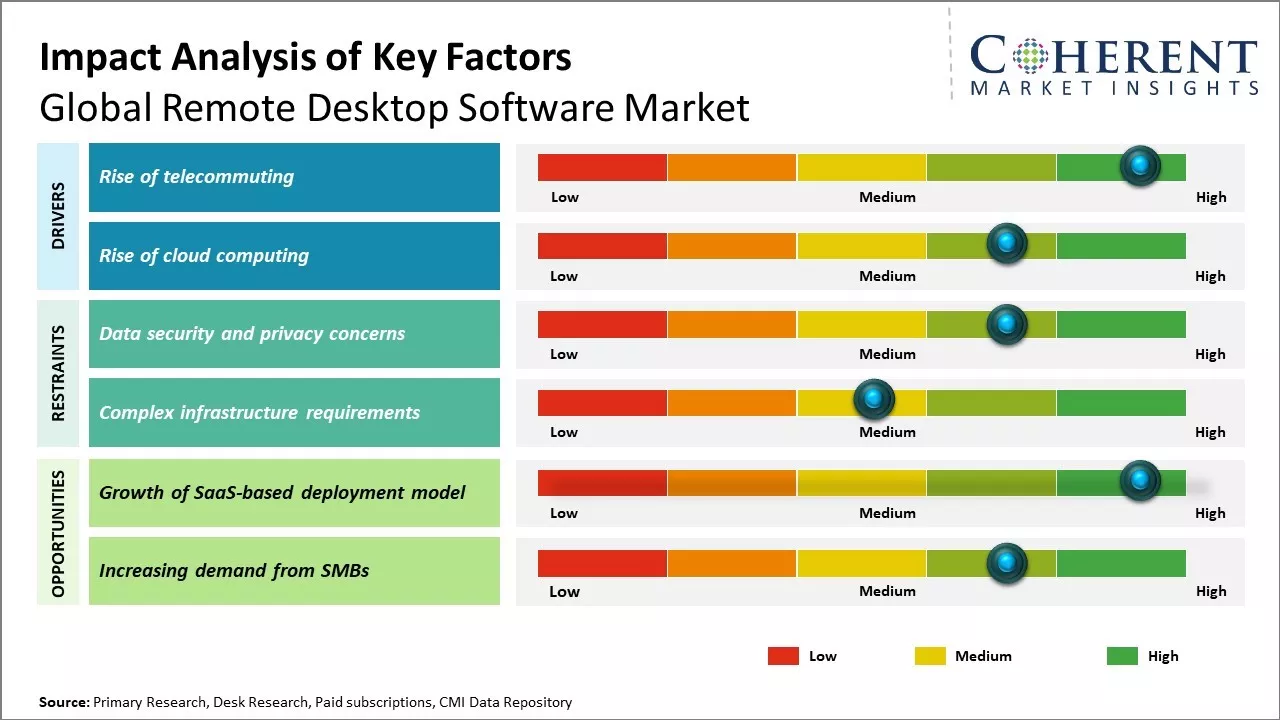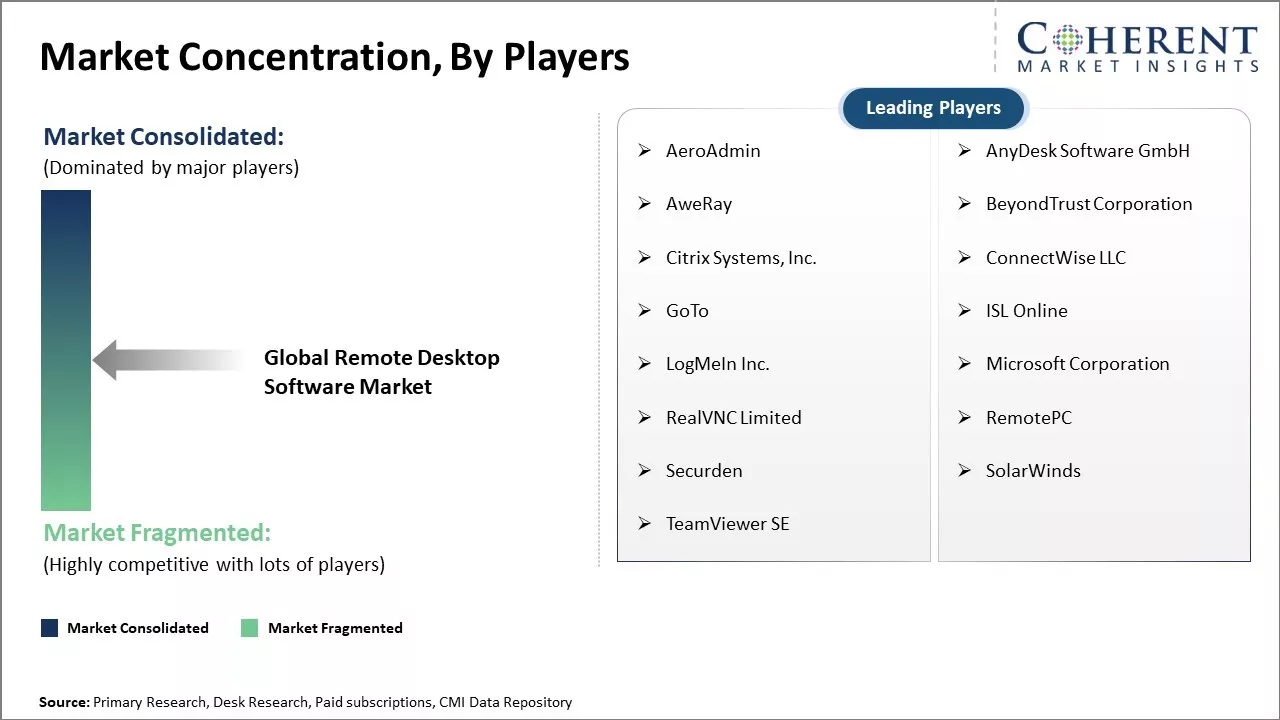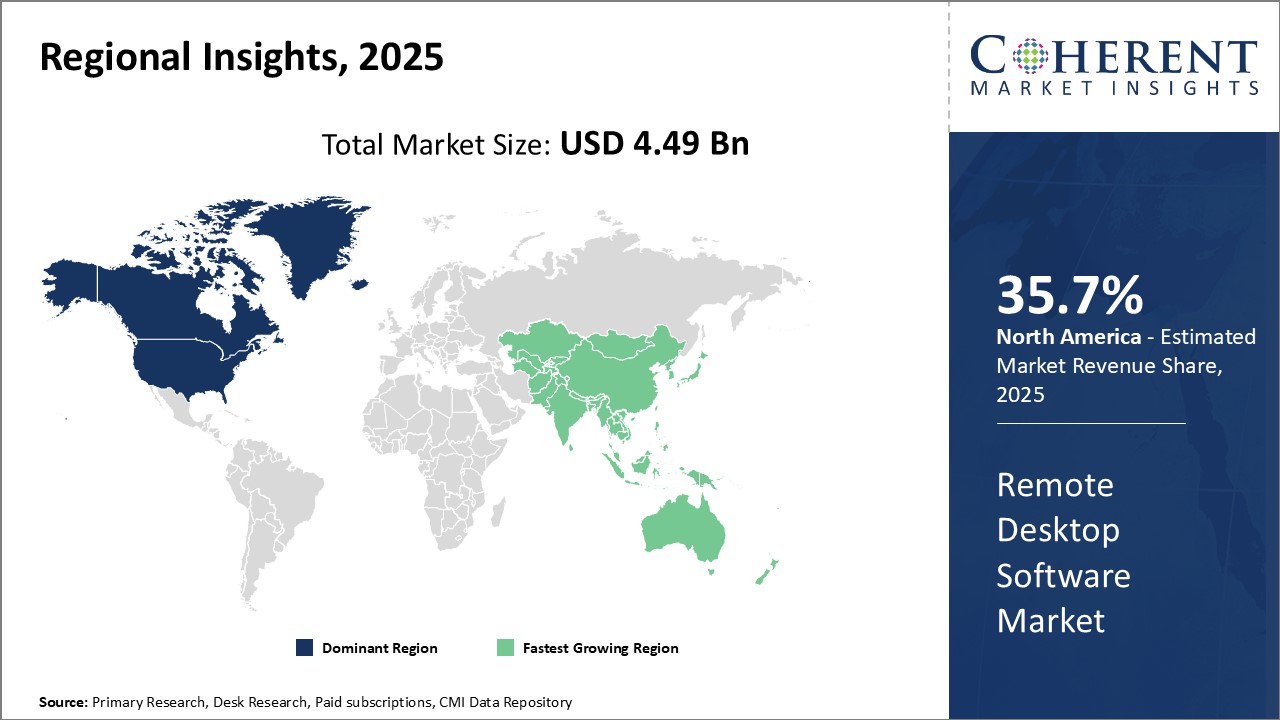Remote Desktop Software Market Size and Trends
The Global Remote Desktop Software Market is estimated to be valued at US$ 4.49 Bn in 2025 and is expected to reach US$ 10.51 Bn by 2032, exhibiting a compound annual growth rate (CAGR) of 12.9% from 2025 to 2032.

Discover market dynamics shaping the industry: Download Free Sample
With the rise in remote and hybrid work culture, the demand for remote desktop software has increased significantly. Many organizations have adopted remote work permanently even after the pandemic and are looking for efficient desktop access and management solutions. Additionally, the software offers advantages like centralized administration, enhanced security, and allows access to organizational networks remotely which has driven their adoption. However, data privacy and security continue to be a challenge and may hamper market growth. Vendors are investing in security features to address these concerns and gain user confidence. Overall, remote desktop software is seen as an essential tool to enable remote work setup and will continue to witness demand growth in coming years.
Drivers of the Market:
Rise of telecommuting
The COVID-19 pandemic has significantly impacted the way organizations operate around the world. As the virus spread rapidly, lockdowns and restrictions were imposed by various governments to curb its spread. This led many businesses to adopt work from home policies for their employees almost overnight. While telecommuting was not new, it was adopted on a massive scale for the first time due to the circumstances.
Organizations realized during this period that remote working can be just as productive as working from the office and does not necessarily impact work output and quality. In fact, some firms reported improved productivity levels from remote employees. Employees also appreciated the flexibility and convenience offered by working from home. It reduced their travel time and costs while allowing them to maintain a work-life balance.
As restrictions ease in many parts of the world, some businesses have now made telecommuting a permanent fixture. They allow flexible work options to employees where they can work from home for a few days every week. This is expected to become a standard practice across various industries going forward. As more companies adopt hybrid or full-time remote setups, there is an increasing demand for remote desktop software that allows employees to access enterprise applications, systems, servers, and workstations from any location.
These software solutions help enterprises securely connect their remote workforce to corporate networks. They provide easy access to critical data, files, business applications and collaboration tools which are needed for employees to be as productive while working offsite as they are in office. With work from home becoming a prominent part of the new normal, remote desktop software are anticipated to see increased adoption globally among businesses to support their distributed and hybrid work models.
Market Concentration and Competitive Landscape

Get actionable strategies to beat competition: Download Free Sample
Rise of cloud computing
Cloud computing has transformed how IT resources are accessed and managed. The scalable, flexible and cost-effective nature of cloud services have led to mass adoption of public clouds by enterprises worldwide across various sectors. As per recent estimates, more than 90% of firms now leverage public cloud infrastructure for one or more of their IT needs.
A key factor driving cloud adoption has been the ability to remotely access cloud-hosted enterprise applications, servers and virtual workstations from anywhere using just a web browser. This allows companies to enable a mobile workforce without physical infrastructure constraints and dependencies. Employees today expect secure access to core business systems wherever they are - whether working from home or while traveling.
Key Takeaways from Analyst:
The global remote desktop software market is expected to witness significant growth over the forecast period driven by the rising adoption of bring-your-own-device culture among organizations. The increasing popularity of remote and flexible working models is also a major factor propelling the demand for remote desktop software. As more companies allow employees to work remotely, the need for secure access to organizational networks from personal devices will continue to rise.
North America currently dominates the market owing to rapid technological advancements and presence of global players in the region. However, Asia Pacific is likely to emerge as the fastest growing regional market in the coming years. This can be attributed to growing digitalization, increasing internet penetration, and rising investments by foreign players in developing countries such as India and China.
Some challenges impeding the market growth include data security concerns, high cost of advanced solutions, and lack of infrastructure in underdeveloped regions. Organizations in price-sensitive developing markets may not adopt premium offerings due to budget constraints. Nevertheless, the market players have opportunities to target cost-conscious customers with low-cost and freemium versions.
Constant innovations around user experience, mobile compatibility, and integration of advanced technologies such as artificial intelligence and cloud computing will be crucial for players to gain competitive edge. Market leaders need to strengthen their partner networks and focus on developing economies to tap into new.
Market Challenges: Data security and privacy concerns
Data security and privacy concerns have become a major challenge restraining the growth of the global remote desktop software market. With the rise of remote and hybrid working models, more organizations are adopting remote desktop software to enable employees to access office desktops and applications from anywhere. However, this has also increased vulnerabilities related to data breaches and privacy leaks. Remote desktop protocols allow sharing of the entire desktop screen and all open applications between devices. This level of access raises the risk of cybercriminals being able to access sensitive organizational data and install malware if the connection is not properly secured. Many employees are also hesitant to use remote desktops for personal devices due to the privacy risks.
Market Opportunities: Growth of SaaS-based deployment model
The rapid proliferation of the SaaS-based deployment model presents a significant opportunity for growth in the global remote desktop software market. With businesses increasingly adopting cloud-based technologies and remote/hybrid workforce models, SaaS remote desktop solutions are providing businesses with easily accessible and cost-effective options for enabling remote work.
SaaS remote desktop deployments eliminate the need for businesses to install, configure, and maintain their own on-premise remote desktop infrastructure. This saves organizations considerable upfront costs and technical complexity compared to licensed or appliance-based alternatives. SaaS solutions also provide enterprises the scalability, flexibility and 24/7 availability to easily support shifting remote work needs. Users can securely access remote desktops from any internet-enabled device using only a web browser. With no client software required, SaaS solutions optimize the remote work experience for employees.

Discover high revenue pocket segments and roadmap to it: Download Free Sample
Insights By Deployment Type - Ease of control drives adoption of on-premise remote desktop software
In terms of deployment type, the on-premise segment is expected to hold 41.7% share of the market in 2025 owing to organizations’ needs for absolute control and customization. On-premise solutions allow IT teams to have full administrative control over software installation and updates. This helps ensure software and security patches are promptly applied to maintain efficacy and protect confidential data within the internal network. On-premise deployment also provides flexibility to customize the software environment based on bespoke enterprise workflows and user preferences. This level of control and customizability addresses privacy and compliance concerns for sensitive industries like healthcare and banking that prefer managing their own on-site infrastructure. Overall, on-premise remote desktop software caters best to enterprises requiring highest data security and complete oversight of their virtual desktop infrastructure.
Insights By Enterprise Size - Enterprise needs drive demand from large organizations
In terms of enterprise size, the large enterprises segment is expected to hold 57.6% share of the market in 2025 owing to substantial requirements for remote access solutions to support large and distributed workforces. Large corporations have more complex IT infrastructure and often operate across multiple geographical locations. This creates significant need for virtual network technologies allowing seamless collaboration between offices as well as remote productivity for mobile employees. Moreover, large enterprises can invest more heavily in robust remote desktop software tailored to their extensive IT architecture and high-capacity user networks. Their deep pockets facilitate adopting premium solutions offering centralized management and multilayer security to protect sprawling digital assets and intellectual property. Overall, large enterprises find most value in sophisticated virtualization platforms that empower collaborative workflows on a large scale.
Insights By End User - Digital transformation fuels adoption in IT and telecom industries
In terms of end user, the IT and telecommunications segment is expected to hold 54.2% share of the market in 2025 owing to growing digitalization efforts constantly modernizing their operations. As technology providers at the forefront of digital transformation, IT and telecom companies extensively leverage cutting-edge networking and remote solutions for maximum employee productivity and efficient upkeep of sophisticated infrastructure. Their work often involves real-time troubleshooting of complex systems remotely. Furthermore, staff in these industries are highly mobile to support on-demand, 24/7 technology requirements of global clients. Remote desktop software allows flexible, secure virtual access to organization’s networks anytime, anywhere. Its usage optimizes resource utilization of these companies aggressively embracing digital technologies and software-defined operations. Overall, remote working and digital mindset make IT and telecom uniquely poised to reap benefits of desktop virtualization.
Regional Insights

Need a Different Region or Segment? Download Free Sample
North America has dominated the global remote desktop software market. The region is expected to account for 35.7% of the market share in 2025 owing to a strong presence of key players in the region. The U.S. alone accounts for more than half of the market share in North America due to a large number of established IT companies based out of the country. These IT giants have been continuously investing in R&D to come up with newer and efficient remote desktop solutions for both individual users and enterprises. With a huge corporate sector and advanced digital infrastructure, the demand for remote connectivity tools is ever-growing in the region.
The Asia Pacific region has emerged as the fastest expanding market for remote desktop software globally in recent times. China and India are spearheading the growth due to their massive workforce depending on remote working solutions. As multinational corporations are setting up offices and R&D facilities in China, the demand for remote access platforms is increasing steadily. In India, the IT sector has witnessed exponential growth in the last decade leading to a boom in freelancing culture and work-from-home concepts. Both individual users and small businesses are readily adopting remote desktop services for better collaboration.
The rising internet penetration and proliferation of low-cost smartphones have boosted the adoption of remote desktop apps in emerging economies of Asia Pacific. The availability of low-cost internet plans and smartphones from Chinese manufacturers has encouraged employees to access corporate networks remotely even from Tier 2 and Tier 3 cities. The increasing volume of cross-border outsourcing projects between Asian countries and Western nations is also propelling the demand. With high-skilled resources at competitive prices, the APAC region is well-positioned to gain more outsourcing contracts requiring remote collaboration in the future. This, in turn, will continue augmenting the uptake of desktop virtualization and management solutions.
Market Report Scope
Remote Desktop Software Market Report Coverage
| Report Coverage | Details | ||
|---|---|---|---|
| Base Year: | 2024 | Market Size in 2025: | USD 4.49 Bn |
| Historical Data for: | 2020 To 2024 | Forecast Period: | 2025 To 2032 |
| Forecast Period 2025 to 2032 CAGR: | 12.9% | 2032 Value Projection: | USD 10.51 Bn |
| Geographies covered: |
|
||
| Segments covered: |
|
||
| Companies covered: |
AeroAdmin, AnyDesk Software GmbH, AweRay, BeyondTrust Corporation, Citrix Systems, Inc., ConnectWise LLC, GoTo, ISL Online, LogMeIn Inc., Microsoft Corporation, RealVNC Limited, RemotePC, Securden, SolarWinds, and TeamViewer SE |
||
| Growth Drivers: |
|
||
| Restraints & Challenges: |
|
||
Uncover macros and micros vetted on 75+ parameters: Get instant access to report
Remote Desktop Software Industry News
- In November 2023, IKEA, a global leader in home furnishings based in Sweden, launched three new budget-friendly smart sensors: VALLHORN, PARASOLL, and BADRING, designed to detect water spillage and motion. These innovative sensors aim to provide customers with greater control and peace of mind, enabling them to stay connected to their homes even when they are away. By offering real-time notifications and seamless integration with the IKEA Home smart app, these products enhance home security and management for users across various living environments.
- In November 2023, Microsoft, a leading global technology company based in Redmond, Washington, introduced a new "Windows App" that enables users to remotely connect to their PCs from iPads, iPhones, and other devices. This app provides a secure method for accessing virtual applications and remote desktops, facilitated by an administrator. The Windows App connects to Windows 365 and other devices, enhancing remote work capabilities and allowing users to manage their workstations seamlessly from various locations.
- In October 2023, Leostream, a Boston-based provider of remote desktop access solutions, launched a new partner program targeting VMware Managed Service Providers (MSPs). The recent developments at Citrix and VMware have created uncertainty in the remote desktop market, presenting an opportunity for Leostream to expand its presence. In an interview with CRN, President Karen Gondoly noted that Broadcom's acquisition of VMware has sparked interest in Leostream's offerings as a cost-effective alternative to VMware's Horizon commercial desktop. Leostream aims to leverage this opportunity to enhance its market position and support partners transitioning from VMware solutions.
- In October 2023, Kaspersky, a global cyber-security giant based in Russia, partnered with TSplus, a renowned provider of remote access solutions, to develop Cyber Immune Solutions tailored for remote workers. This collaboration aims to enhance cyber-security for remote desktop environments by integrating Kaspersky's KasperskyOS operating system and related Cyber Immune software products with TSplus' remote desktop and application delivery solutions. The partnership is designed to address the growing demand for secure remote work solutions in an increasingly digital landscape.
- In December 2021, TSplus, a leading provider of remote access and web portal solutions based in France, announced the official release of Remote Access Version 15, a major update to its flagship remote access software. This new version comes with a Lite Administrative Interface and a streamlined setup process, making it easier for first-time users to quickly start leveraging the application's valuable features. The Lite Mode simplifies the configuration and management of remote access, while the enhanced setup guides users through the installation and initial setup, ensuring a smooth onboarding experience.
*Definition: The Global Remote Desktop Software Market allows users to access computers remotely over a network connection or through the internet. It provides a graphical user interface that can be accessed from a remote computer system. This software enables users to see the desktop of another device including files, applications, and settings. It allows for remote administration, support and collaboration. Popular uses include providing technical support for customers, sharing desktops across offices, and working from home securely.
Market Segmentation
- Deployment Type Insights (Revenue, US$ Bn, 2020 - 2032)
- On-premise
- Cloud
- Web-based
- Enterprise Size Insights (Revenue, US$ Bn, 2020 - 2032)
- Small and Medium Enterprises
- Large Enterprises
- End User Insights (Revenue, US$ Bn, 2020 - 2032)
- Government
- IT and Telecommunications
- BFSI
- Healthcare
- Retail
- Education
- Media and Entertainment
- Others
- Regional Insights (Revenue, US$ Bn, 2020 - 2032)
- North America
- U.S.
- Canada
- Latin America
- Brazil
- Argentina
- Mexico
- Rest of Latin America
- Europe
- Germany
- U.K.
- Spain
- France
- Italy
- Russia
- Rest of Europe
- Asia Pacific
- China
- India
- Japan
- Australia
- South Korea
- ASEAN
- Rest of Asia Pacific
- Middle East & Africa
- GCC Countries
- Israel
- South Africa
- Rest of Middle East & Africa
- North America
- Key Players Insights
- AeroAdmin
- AnyDesk Software GmbH
- AweRay
- BeyondTrust Corporation
- Citrix Systems, Inc.
- ConnectWise LLC
- GoTo
- ISL Online
- LogMeIn Inc.
- Microsoft Corporation
- RealVNC Limited
- RemotePC
- Securden
- SolarWinds
- TeamViewer SE
Share
Share
About Author
Ankur Rai is a Research Consultant with over 5 years of experience in handling consulting and syndicated reports across diverse sectors. He manages consulting and market research projects centered on go-to-market strategy, opportunity analysis, competitive landscape, and market size estimation and forecasting. He also advises clients on identifying and targeting absolute opportunities to penetrate untapped markets.
Missing comfort of reading report in your local language? Find your preferred language :
Transform your Strategy with Exclusive Trending Reports :
Frequently Asked Questions
EXISTING CLIENTELE
Joining thousands of companies around the world committed to making the Excellent Business Solutions.
View All Our Clients
